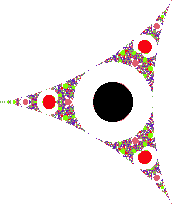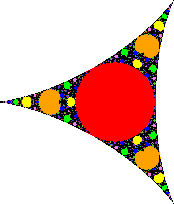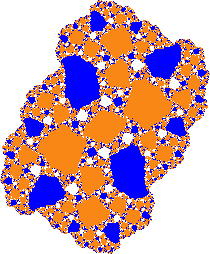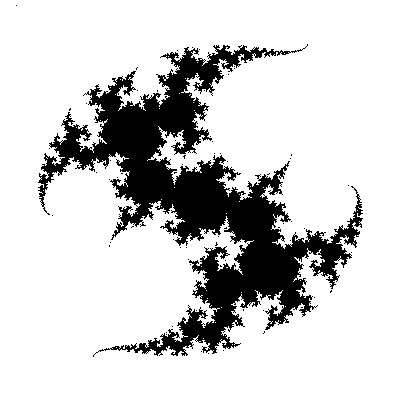Negative-exponent fractals
 To compute a point in the Mandelbrot set, the equation z = z^2+c is repeated
many times. If z exceeds 4, it will grow to infinity, and the point is
outside the Mandelbrot set. Similar sets can be generated for exponents of 3,
4, etc.
To compute a point in the Mandelbrot set, the equation z = z^2+c is repeated
many times. If z exceeds 4, it will grow to infinity, and the point is
outside the Mandelbrot set. Similar sets can be generated for exponents of 3,
4, etc.
What happens if you want to use a negative exponent such as -2?
You can use a similar mechanism, and declare that a point has escaped if
it exceeds a bound. However, unlike the positive exponent case, large
values don't really escape, since z^-2 is very small if z is very large,
so the z values come back. Thus, the results depend on the bound selected
and show artifacts, which appear as concentric circles.
 A better solution is to see if the sequence of z values forms a cycle.
For some values of c, z will converge to a fixed value. For others, z will
oscillate between two or more values. In other cases, z will chaotically
wander. By coloring each point according to the cyclic behavior, we
can see the true structure of the fractal without artifacts that depend
on the escape bound, as shown on the left. (The result is reminiscent of
Mobius fractals.)
A better solution is to see if the sequence of z values forms a cycle.
For some values of c, z will converge to a fixed value. For others, z will
oscillate between two or more values. In other cases, z will chaotically
wander. By coloring each point according to the cyclic behavior, we
can see the true structure of the fractal without artifacts that depend
on the escape bound, as shown on the left. (The result is reminiscent of
Mobius fractals.)
 With c fixed and z varying, a Julia set is created. Negative-exponent
fractals show a variety of Julia sets, depending on which c value is
selected. To compute the Julia set, again the cycles must be detected.
However, for the Julia set, every point will converge to the same cycle.
The figure can be colored according to the "phase" of the cycle, though.
This yields the following images.
With c fixed and z varying, a Julia set is created. Negative-exponent
fractals show a variety of Julia sets, depending on which c value is
selected. To compute the Julia set, again the cycles must be detected.
However, for the Julia set, every point will converge to the same cycle.
The figure can be colored according to the "phase" of the cycle, though.
This yields the following images.

For more details, see my
paper, which was published as
``An Investigation of z -> 1/z^n+c,''
Computers & Graphics, 17(5), Sep. 1993, pp 603-607.

Ken Shirriff:
[email protected]
This page:
http://www.righto.com/fractals/neg.html
Copyright 2000 Ken Shirriff. Last updated 9/22/2000.
 A better solution is to see if the sequence of z values forms a cycle.
For some values of c, z will converge to a fixed value. For others, z will
oscillate between two or more values. In other cases, z will chaotically
wander. By coloring each point according to the cyclic behavior, we
can see the true structure of the fractal without artifacts that depend
on the escape bound, as shown on the left. (The result is reminiscent of
Mobius fractals.)
A better solution is to see if the sequence of z values forms a cycle.
For some values of c, z will converge to a fixed value. For others, z will
oscillate between two or more values. In other cases, z will chaotically
wander. By coloring each point according to the cyclic behavior, we
can see the true structure of the fractal without artifacts that depend
on the escape bound, as shown on the left. (The result is reminiscent of
Mobius fractals.)
 To compute a point in the Mandelbrot set, the equation z = z^2+c is repeated
many times. If z exceeds 4, it will grow to infinity, and the point is
outside the Mandelbrot set. Similar sets can be generated for exponents of 3,
4, etc.
To compute a point in the Mandelbrot set, the equation z = z^2+c is repeated
many times. If z exceeds 4, it will grow to infinity, and the point is
outside the Mandelbrot set. Similar sets can be generated for exponents of 3,
4, etc.
 With c fixed and z varying, a Julia set is created. Negative-exponent
fractals show a variety of Julia sets, depending on which c value is
selected. To compute the Julia set, again the cycles must be detected.
However, for the Julia set, every point will converge to the same cycle.
The figure can be colored according to the "phase" of the cycle, though.
This yields the following images.
With c fixed and z varying, a Julia set is created. Negative-exponent
fractals show a variety of Julia sets, depending on which c value is
selected. To compute the Julia set, again the cycles must be detected.
However, for the Julia set, every point will converge to the same cycle.
The figure can be colored according to the "phase" of the cycle, though.
This yields the following images.

